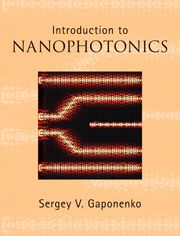1 - Introduction
Published online by Cambridge University Press: 05 June 2012
Summary
Light and matter on a nanometer scale
The notion of “photonics” implies the science and technology related to generation, absorption, emission, harvesting, processing of light and their applications in various devices. Light is electromagnetic radiation available for direct human perception, in the wavelength range from approximately 400 to approximately 700 nanometers. Typically, adjacent far ultraviolet and near infrared ranges are also involved to give the approximate range of electromagnetic radiation from 100 nanometers to 1–2 micrometers as the subject of photonics. If the space has certain inhomogeneities on a similar scale to the wavelength of the light, then multiple scattering and interference phenomena arise modifying the propagation of light waves. Light scattering is the necessary prerequisite for vision. Shining colors in soap bubbles and thin films of gasoline on a wet road after rain are primary experiences of light-wave interference everybody gains in early childhood. To modifiy the conditions for light propagation, inhomogeneities in space which are not negligible as compared to the wavelength of the light, i.e. starting from the size range 10–100 nm to a few micrometers, become important. Space inhomogeneity for light waves implies inhomogeneity in dielectric permittivity.
Matter is formed from atoms which in turn can be subdivided into nuclei and electrons. An elementary atom of hydrogen has a radius for the first electron orbital of 0.053 nm. Atoms may form molecules and solids.
- Type
- Chapter
- Information
- Introduction to Nanophotonics , pp. 1 - 6Publisher: Cambridge University PressPrint publication year: 2010



